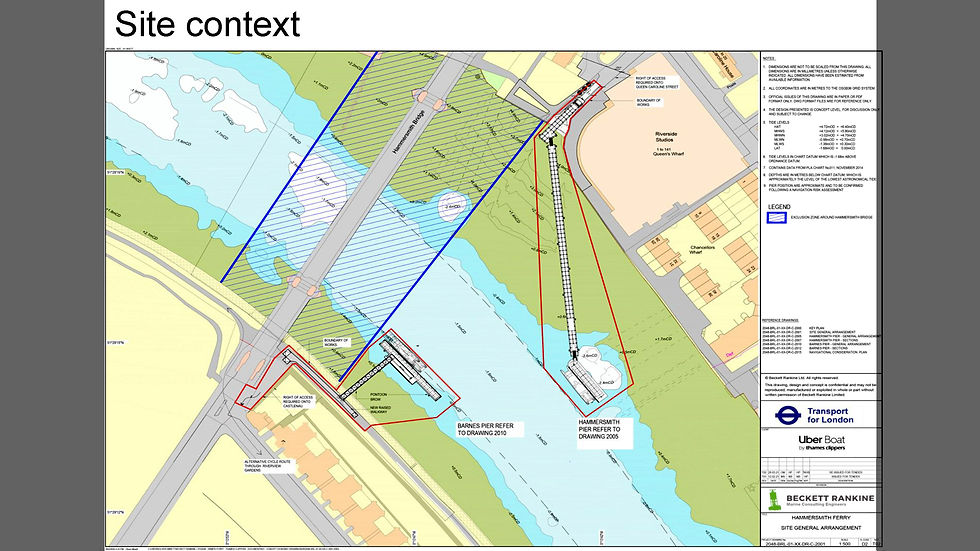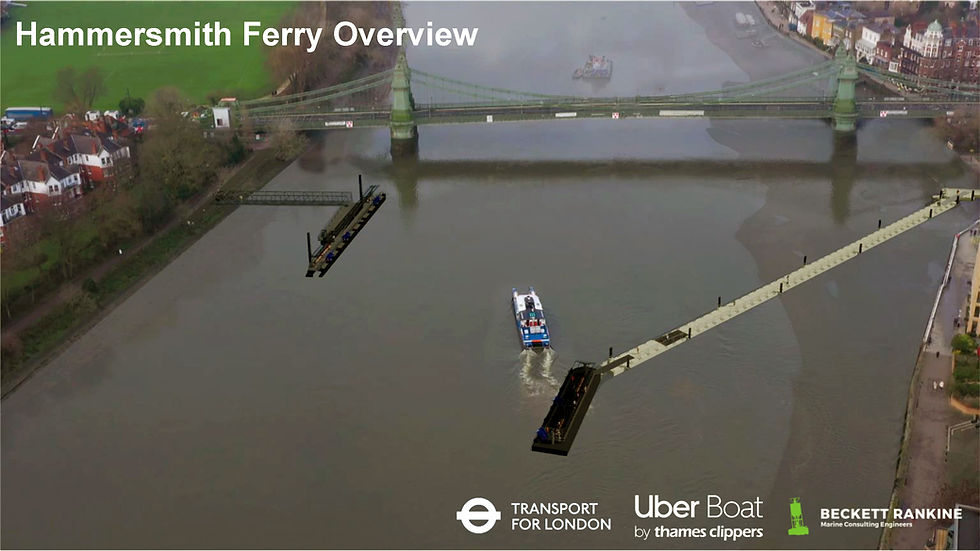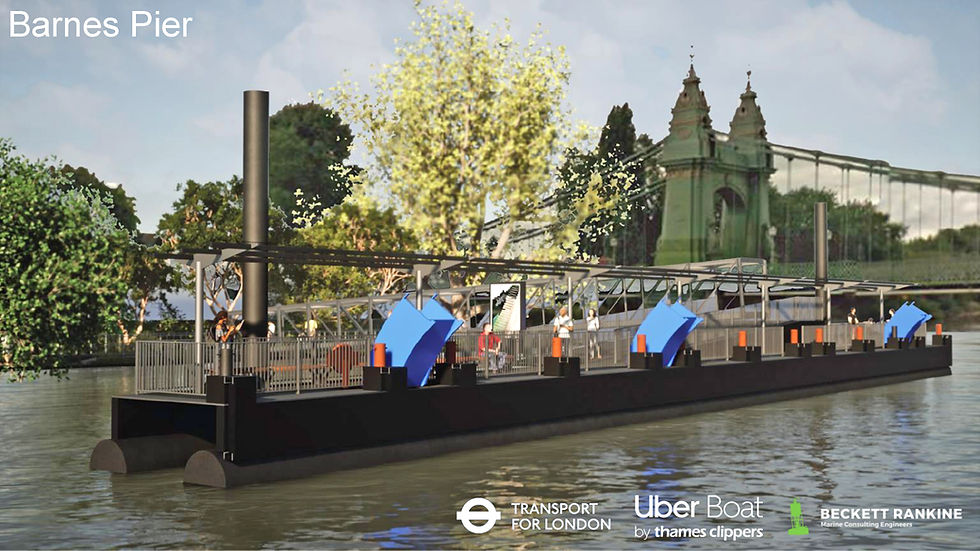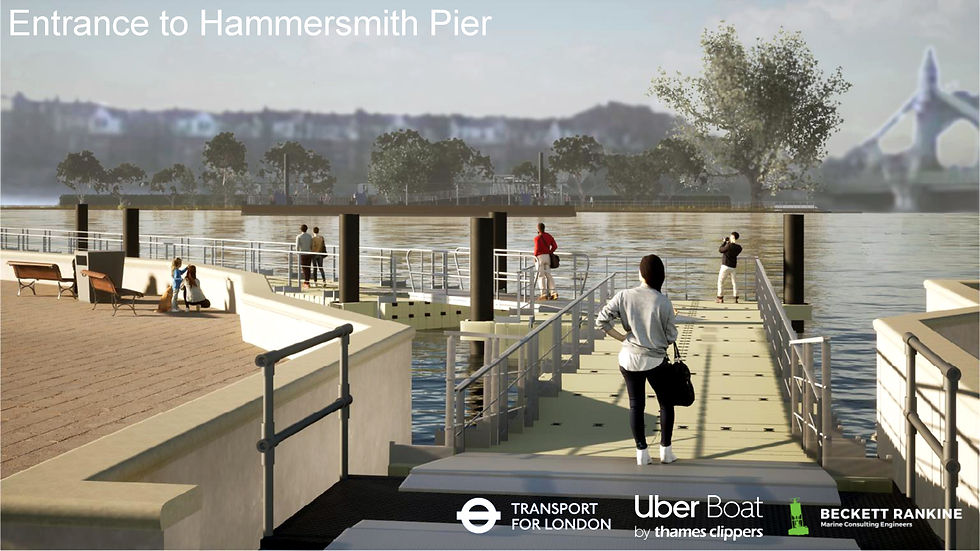HBSOS Meeting #2 with TfL re Ferry 23 April 2021
- Hammersmith Bridge SOS Team
- Apr 23, 2021
- 5 min read
Updated: Apr 26, 2021
Members of HBSOS Steering Group (SG) again met virtually with Transport for London (TfL) on Friday 23rd April 2021 to get a further up-date on the ferry. Below is a summary from this meeting with some accompanying images that TFL shared with us.
The HBSOS SG members were: Raphael Zachary-Younger, Julia Llewellyn-Smith, Michelle Coulter and Deirdre Hutton
There were various officials from TfL, led by Andrew Lund, and Nick Waterman as their main communications person.
Also present from Beckett Rankine was Tim Beckett, and from Thames Clippers, their Chief Operating Officer, Geoff Symonds
This grouping of people on the Provider side made for a helpful and informative meeting: Beckett Rankine have been awarded the contract for the pier infrastructure, and as we know Thames Clippers will be running the ferry.
The main points that came out of the meeting concerned ferry operations, the numbers of passengers (N.B. times and numbers are revised from the figures quoted by Heidi Alexander in her letter of 16th April and also our previous meeting with TfL), the ferry route, pier infrastructure and communications:
Ferry Operations: There will be three boats engaged in this operation, two running and one as a back-up. The ferries will be able to operate at all states of the tide and will run for a minimum of a year. The hours of operation will be:
Weekdays: 0600 - 2200
Weedends: 0800 - 2200
The frequency of operation will be between 5-7 minutes in either direction during peak hours and 10-12 minutes off-peak. The crossing itself will take 90 seconds and because of the way the service is planned the boats do not need to turn round, which obviously saves a lot of time. There will be two boarding gates on the ferry, one of which will be used for pedestrians, wheel chairs and scooters, with the other being used for cycles.
Thames Clippers will have two staff on the piers at all times to assist with embarking and disembarking, taking tickets etc. There was considerable emphasis throughout on the importance of enabling access for people in wheelchairs, and those who are less mobile.
TfL were clear they had heard our objections to the overly short hours of operation and said that there was flexibility in the schedule if demand required it, though they indicated that an extension would mean increased costs. They also emphasised that there were objections to the ferry operation from residents and shortening the late hours was a way of trying to find a balance between residents and ferry users. However, it was also pointed out the ferries would be very quiet with one direction always using the tide to allow it to navigate without its engine. These ferries are used around Putney where there have been no noise problems.
Thames Clippers said that they have experience of transporting school children because they regularly take pupils from Westminster School. They also thought it might reassure parents if some of the schools sent one person to act as chaperone on the ferry. This would help with numbers if parents otherwise thought they needed to accompany their children.
TfL still hope to have the ferry running by the beginning of the Autumn Term, but are as yet unable to commit to that date.
Passenger Numbers: The news on passenger numbers was good:
The initial plan is for 1,116 movements per hour (558 each way) during peak hours
However, Geoff Symonds was clear that as the service bedded in and people got used to getting on and off the ferry, these numbers would quickly increase and he envisaged a possible total of near 1500 passengers per hour (750 each way).
N.B. one passenger movement = one crossing in either direction

Ferry route: As per the image above the route of the ferry will be from Queen Caroline Street Wharf on the north side to just east of Hammersmith Bridge on the south side. On the Barnes side there will be a bridge out from path level to a floating pontoon, while on the Hammersmith side there will be a long floating walkway out to a landing platform. The floating walkway on the north side is skewed downstream to allow for various difficulties, namely navigation by other boats under Hammersmith Bridge and around sewage outfalls. The diagram slide shows that the walkway on the north side has to be long in order to get over the land (coloured green) which is exposed at low tide.
The following images show the route from an aerial perspective and simulated pictures of the piers themselves. They were created for the tender put in by Beckett Rankine and there may be some small future modifications required by TfL, for example continuous railing for safety reasons. Essentially they give a good idea of what it will look like even if not identical.




Pier infrastructure: The pier infrastructure will be built by Beckett Rankine. Tim Beckett pointed out that delay could be caused by the need for planning permissions although this should be easier since the land is owned either by the Port Of London Authority (PLA) or the Local Authority. Normally his company would wait for permissions before starting construction, but in this case was going to run the work in parallel. The works would be designed to be temporary in nature so they could be easily removed when the ferry was no longer necessary. There would be seats and shelters. The path would be raised, re-surfaced and lighting provided to make it safe and dry.
Communications: The HBSOS SG members urged TfL to be as open as possible as quickly as possible. TfL responded by saying that they were keen to talk to as many people in the community as they could but first needed to wait till after the Mayoral Elections on 6th May and secondly would like to get their planning permissions in so that they can be sure of all the details. These planning applications should be submitted within the next month.
So from 14th May we hope we can expect more detailed drawings.
TfL are looking at whether there are other small changes (eg provision of benches or a place for taxis to wait), which would make access to Castelnau as easy as possible. But these seemed to be very initial thoughts and would be widely consulted on.
Finally we suggested that TfL might be able to do a larger Teams or Zoom call through the HBSOS WhatsApp group which will give more people access to TfL’s plans.
Meanwhile TfL are asking the public to email them at hammersmithbridge@tfl.gov.uk to let them know their thoughts on the ferry e.g. how long it’s taking to put it in place, the potential routes, landing points, proposed capacity and running hours etc.
UPDATE 26 April 2021
Fares: The fares structure proposed for the ferry will contribute to funding its operation and has been chosen at the lowest level possible. Fares are expected to mirror buses at £1.55, subject to necessary approvals. This would include a Hopper option and the acceptance of the same concessions, including Freedom Passes and free travel for children. The Hopper option will allow people who arrive at the ferry by bus to change onto the ferry at no further charge, as long as they change within an hour of starting their original journey. The fare will also fall under the the pay-as-you-go capped fare limits when using the same contactless card, device or Oyster card for travel during a single day.



Comments